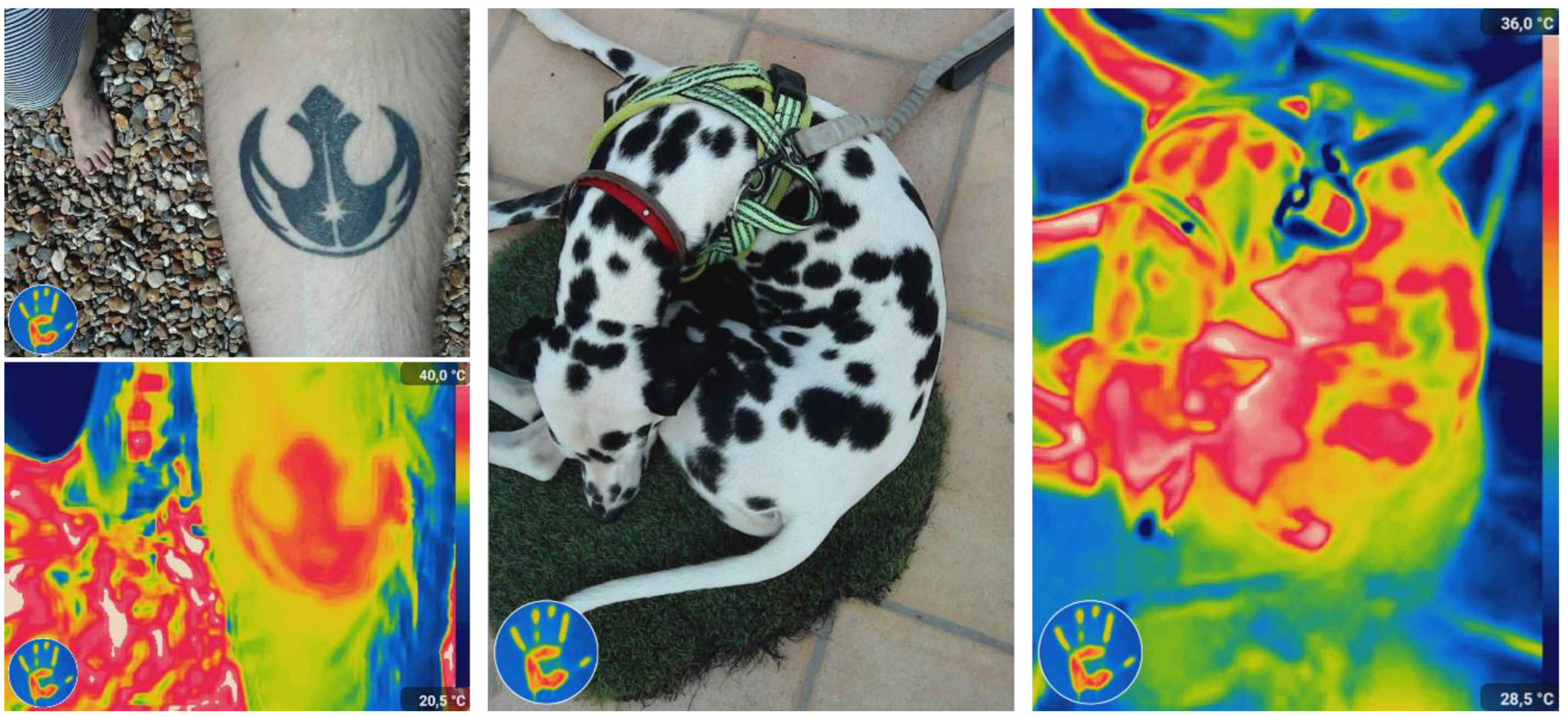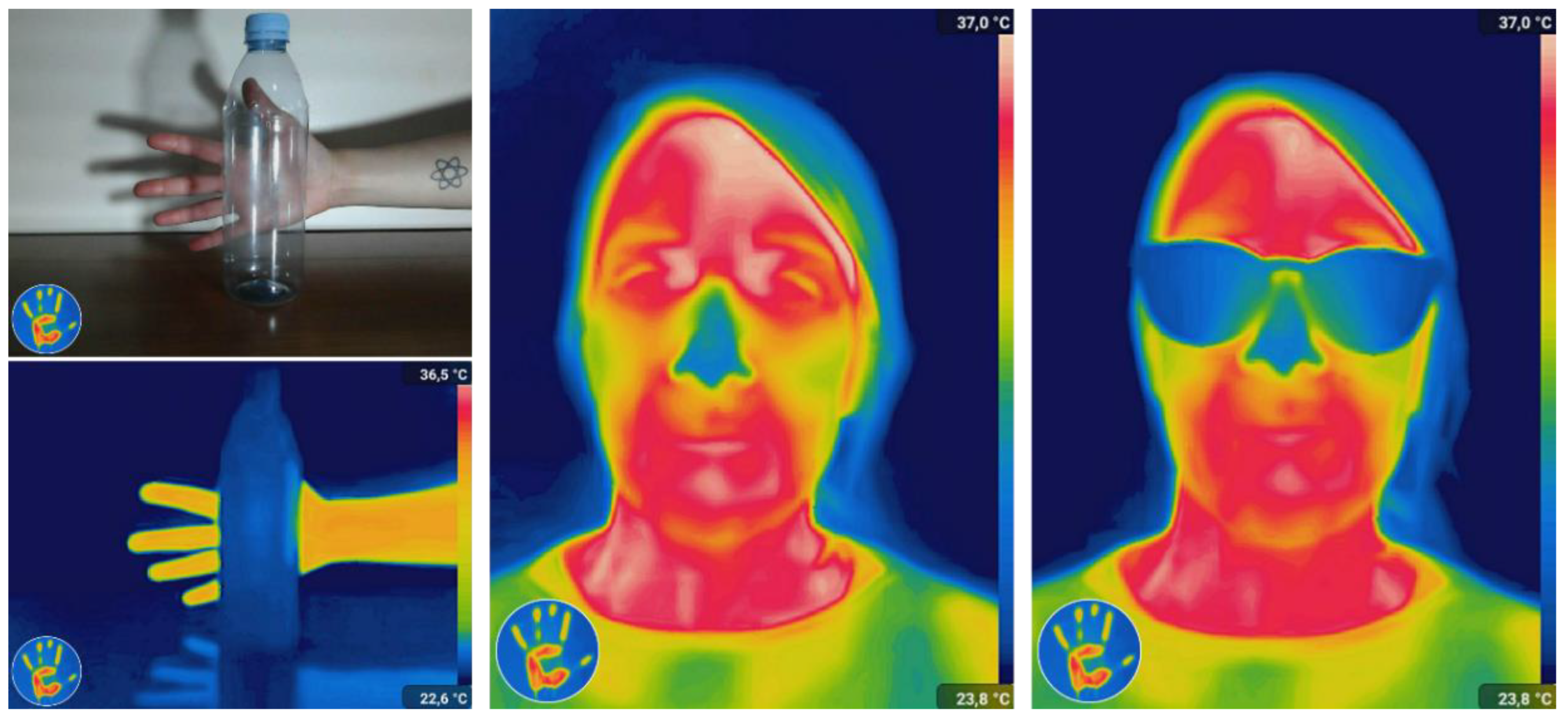@thermogramer: Thermal Imaging as a Tool for Science Communication and E-Learning in Social Media
Abstract
1. Introduction
2. Materials and Methods
2.1. Multispectral Imaging
2.2. Social Media Platforms
3. Results and Discussion
3.1. Designing Simple Home-Made Tests on @thermogramer for E-Learning Thermography and Heat Science Concepts
3.2. Impact of @thermogramer on the General Public
4. Conclusions
Funding
Institutional Review Board Statement
Informed Consent Statement
Data Availability Statement
Acknowledgments
Conflicts of Interest
References
- Mariš, L.; Adamová, V. Global Economic Impacts of COVID 19 to Increase the Protection of Society by Using Thermal Imaging Cameras to Measure the Temperature of Human Body. SHS Web Conf. 2021, 92, 01031. [Google Scholar] [CrossRef]
- Wilson, T.; Wilson, D. The Noninvasive Laboratory—History and Future of Thermography. Angiol. J. Vasc. Dis. 1985, 36, 341–353. [Google Scholar] [CrossRef]
- Valleriani, M. Galileo Engineer; Springer Science and Business Media: Amsterdam, The Netherlands, 2010. [Google Scholar]
- Ring, E.F.J. History of thermology and thermography: Pioneers and progress. Thermol. Int. 2012, 22, 3–7. [Google Scholar]
- Plank, M. On an Improvement of Wien’s Equation for the Spectrum. Ann. Phys. 1900, 1, 719–721. [Google Scholar]
- Meola, C. Infrared Thermography Recent Advances and Future Trends; Bentham Books: Sharjah, United Arab Emirates, 2012; ISBN 978-1-60805-521-0. [Google Scholar]
- Vollmer, M.; Möllmann, K.-P. Infrared Thermal Imaging: Fundamentals, Research and Applications, 2nd ed.; Wiley: London, UK, 2017. [Google Scholar]
- Ferreira, M.E.; André, A.C.; Pitarma, R. Potentialities of thermography in ecocentric education of children: An experience on training of future primary teachers. Sustainability 2019, 11, 2668. [Google Scholar] [CrossRef]
- Vollmer, M.; Möllmann, K.P. Infrared cameras as accessories to smartphones: Facts you need to know. Phys. Educ. 2018, 53. [Google Scholar] [CrossRef]
- Haglund, J.; Jeppsson, F.; Melander, E.; Pendrill, A.M.; Xie, C.; Schönborn, K.J. Infrared cameras in science education. Infrared Phys. Technol. 2016, 75, 150–152. [Google Scholar] [CrossRef]
- Rodriguez-Gonzalvez, P.; Rodriguez-Martín, M. Design of a didactical activity for the analysis of uncertainties in thermography through the use of robust statistics as teacher-oriented approach. Remote Sens. 2021, 13, 402. [Google Scholar] [CrossRef]
- Green, T.C.; Gresh, R.H.; Cochran, D.A.; Crobar, K.A.; Blass, P.M.; Ostrowski, A.D.; Campbell, D.J.; Xie, C.; Torelli, A.T. Invisibility Cloaks and Hot Reactions: Applying Infrared Thermography in the Chemistry Education Laboratory. J. Chem. Educ. 2020, 97, 710–718. [Google Scholar] [CrossRef]
- Collins, K.; Shiffman, D.; Rock, J. How are scientists using social media in the workplace? PLoS ONE 2016, 11, 1–10. [Google Scholar] [CrossRef] [PubMed]
- Mnkandla, E.; Minnaar, A. The Use of Social Media in E-Learning: A Metasynthesis. Int. Rev. Res. Open Distrib. Learn. 2017, 18, 227–248. [Google Scholar] [CrossRef]
- Yammine, S.Z.; Liu, C.; Jarreau, P.B.; Coe, I.R. Social media for social change in science. Science 2018, 360, 162–163. [Google Scholar] [CrossRef] [PubMed]
- Quilty, B.J.; Clifford, S.; Flasche, S.; Eggo, R.M. Effectiveness of airport screening at detecting travellers infected with novel coronavirus (2019-nCoV). Eurosurveillance 2020, 25, 1–6. [Google Scholar] [CrossRef] [PubMed]
- Slade, D.H.; Sinha, M.S. Return to work during coronavirus disease 2019 (COVID-19): Temperature screening is no panacea. Infect. Control Hosp. Epidemiol. 2021, 44, 1166–1167. [Google Scholar] [CrossRef] [PubMed]
- Huizenga, C.; Zhang, H.; Arens, E.; Wang, D. Skin and core temperature response to partial- and whole-body heating and cooling. J. Therm. Biol. 2004, 29, 549–558. [Google Scholar] [CrossRef]
- Lacasa, A. Journalist Discovers He Has Fever On-Air At Hospital. Fourth Estate Alliance, 17 April 2020. Available online: https://fourthestatealliance.org/on-air-journo-checks-temp-at-covid-hospital-has-fever/ (accessed on 23 December 2021).
- Thermal Camera Pointing through Face Shield. Europapress Photos, 11 May 2020. Available online: https://fotos.europapress.es/temasactualidad/f3073902/ (accessed on 23 December 2021).
- Yeo, S.K.; Su, L.Y.F.; Cacciatore, M.A.; McKasy, M.; Qian, S. Predicting Intentions to Engage With Scientific Messages on Twitter: The Roles of Mirth and Need for Humor. Sci. Commun. 2020, 42, 481–507. [Google Scholar] [CrossRef]
- Bourzac, K. Hot Pics. Chem. Eng. News 2019, 97, 48. Available online: https://pubs.acs.org/doi/10.1021/cen-09729-newscripts (accessed on 23 December 2021).
- Aguiar, A.R. Las cámaras térmicas que las empresas estáninstalando para frenar el coronavirus no soninfalibles: Se pueden “hackear” con agua fría, mascarillas o reflejos de luz. Business Insider, 11 May 2020, 1–8. Available online: https://www.businessinsider.es/pueden-hackear-camaras-termicas-frenar-coronavirus-636955 (accessed on 23 December 2021).
- Aguiar, A.R. Así registra una cámara térmica la temperaturade tu cara si te has mojado con agua fría o llevas gafas: Los puntos ciegos de una tecnología esencial para la desescalada. Business Insider, 12 May 2020, 1–9. Available online: https://www.businessinsider.es/6-fotos-camara-termica-frente-caras-agua-fria-gafas-638459 (accessed on 23 December 2021).
- “La Sexta” Noche TV Show on the Spanish National TV channel “La Sexta” (Broadcasted on 10 October 2020). Available online: https://www.atresplayer.com/lasexta/programas/lasexta-noche/2020/10-10-20-jose-luis-martinez-almeida-mercedes-mila-y-miguel-sebastian_5f80426b7ed1a89e4ce69144/ (accessed on 23 December 2021).
- “La Hora 1” TV Show -Termómetros, ¿cuál es el más efectivo?- on the Spanish National TV channel “La 1” (Broadcasted on 10/11/2020). Available online: https://www.rtve.es/noticias/20201110/mejor-termometro-fiebre-temperatura-coronavirus-covid/2054794.shtml (accessed on 23 December 2021).
- “Zapeando” TV Program, Episode 1626 on the Spanish National TV Channel “La Sexta” (Broadcasted on 29 June 2020). Available online: https://www.atresplayer.com/lasexta/programas/zapeando/temporada-1/29-06-20_5efa07077ed1a8c67af7b434/ (accessed on 23 December 2021).
- “Espejo Público” TV Show on the Spanish National TV channel “Antena 3” (Broadcasted on 24 August 2020). Available online: https://www.instagram.com/tv/CaqFKTPle7G/?utm_medium=copy_link (accessed on 3 March 2022).
- Galicia Futura” Museum Exhibition in Gaiás Museum, Santiago de Compostela (Spain) from 14 July 2021 to 9 January 2022. Available online: https://www.cidadedacultura.gal/gl/system/files/downloads/2021/07/galiciafutura_english_texts.pdf (accessed on 23 December 2021).
- Holy Year Xacobeo 2021–2022. Available online: https://xacobeo2021.caminodesantiago.gal/en/home (accessed on 23 December 2021).
- “Orbita Laika” Science Communication TV Show on the Spanish National TV Channel “La 2” (Broadcasted on 14 Decmeber 2021). Available online: https://www.rtve.es/play/videos/orbita-laika/orbita-laika-spain-quimica/6246319/ (accessed on 23 December 2021).




| Questions | Answers | Instagram (n = 74) | Twitter (n = 77) |
|---|---|---|---|
| Did you know what is thermal imaging (or thermography) before following @thermogramer? | Yes | 75.7% | 77.9% |
| No | 21.6% | 22.1% | |
| I thought it was another thing | 1.3% | 0.0% | |
| Do you follow more channels/accounts about thermal imaging or thermography? | Yes | 6.8% | 2.6% |
| No | 87.8% | 96.1% | |
| Do you follow more channels/accounts about science communication? | Yes | 70.3% | 97.4% |
| No | 29.7% | 2.6% | |
| Why do you follow @thermogramer? | Thermal Images | 8.1% | 5.2% |
| Science explanations | 13.5% | 18.2% | |
| Both | 66.2% | 41.6% | |
| Other | 5.4% | 5.2% | |
| Do you consider that thermal cameras are important in our society? | Yes | 94.6% | 80.5% |
| No | 4.0% | 6.5% | |
| Taking into account that soon enough we all could have thermal cameras in our smartphone, do you consider important to know the science behind these instruments? | Yes | 89.2% | 77.9% |
| No | 6.8% | 9.1% | |
| About what did you learn in @thermogramer? | New technologies | 44.6% | 45.5% |
| Environment | 14.8% | 11.7% | |
| Health and self-care | 13.5% | 7.8% | |
| Other | 5.4% | 10.4% | |
| If you work in education or science communication, would you use any content from @thermogramer for teaching? | Yes, I already did it. | 6.8% | 7.8% |
| Yes, I will do it. | 44.6% | 36.4% | |
| No, it is not adequate for me. | 23.0% | 23.4% |
Publisher’s Note: MDPI stays neutral with regard to jurisdictional claims in published maps and institutional affiliations. |
© 2022 by the author. Licensee MDPI, Basel, Switzerland. This article is an open access article distributed under the terms and conditions of the Creative Commons Attribution (CC BY) license (https://creativecommons.org/licenses/by/4.0/).
Share and Cite
Bermudez-Garcia, J.M. @thermogramer: Thermal Imaging as a Tool for Science Communication and E-Learning in Social Media. Sustainability 2022, 14, 3096. https://doi.org/10.3390/su14053096
Bermudez-Garcia JM. @thermogramer: Thermal Imaging as a Tool for Science Communication and E-Learning in Social Media. Sustainability. 2022; 14(5):3096. https://doi.org/10.3390/su14053096
Chicago/Turabian StyleBermudez-Garcia, Juan Manuel. 2022. "@thermogramer: Thermal Imaging as a Tool for Science Communication and E-Learning in Social Media" Sustainability 14, no. 5: 3096. https://doi.org/10.3390/su14053096
APA StyleBermudez-Garcia, J. M. (2022). @thermogramer: Thermal Imaging as a Tool for Science Communication and E-Learning in Social Media. Sustainability, 14(5), 3096. https://doi.org/10.3390/su14053096






